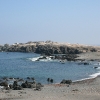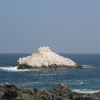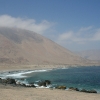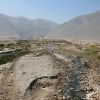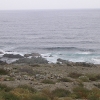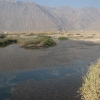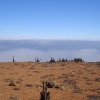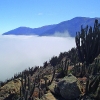Settlement pattern
As seafaring nomads, the Chonos moved around from island to island without having a home base. They spent most of their lives on board their dalcas, moving the entire family around to where resources were most plentiful and taking all of their belongings with them. The vessels were even dismantled and dragged over land when required.
They erected dwellings in the shape of a flattened cone at their temporary camps. These elliptical shaped structures consisted of a series of long, straight branches set into the ground and leaning inward. The branches were tied together at the apex with plant fibers. The Chonos covered the floor of their dwellings with dry branches to keep out the cold, while the structure itself was covered with leaves, skins and bark to keep out the wind. As covering materials were not easily obtained, the people took them along in the dalca when they moved.
The huts had a single, small entrance, and their size depended on the number of people they housed. The hearth was in the middle to provide heat for warmth and for cooking. The huts had no smoke holes, which made them uncomfortable to live in. When a Chono group left a camp, they left the frame in place for future occupants. These temporary camps seem to have been located close to one or more key resources, such as freshwater, and the Chonos used them as a base from which they hunted and gathered other resources. Middens have been found at these camp sites due to their frequent consumption of shellfish. Some of these piles of waste shells are up to 100m wide and four meters deep.


